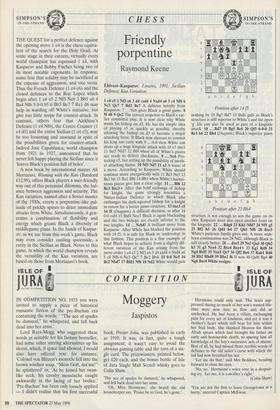SIMPSON'S
IN-THE•STRAND
A
771.7
SIMPSON'S
IN-THE-STRAND
THE QUEST for a perfect defence against the opening move 1 e4 is the chess equiva- lent of the search for the Holy Grail. At some stage in their careers, virtually every world champion has espoused 1 e4, with Kasparov and Bobby Fischer being two of its most notable exponents. In response, some fear that solidity may be sacrificed at the expense of aggression, and vice versa. Thus the French Defence (1 e4 e6) and the closed defences to the Ruy Lopez which begin after 1 e4 e5 2 Nf3 Nc6 3 Bb5 a6 4 Ba4 Nf6 5 0-0 b5 6 Bb3 Be7 7 Rel d6 may help in warding off White's initiative, but give too little scope for counter-attack. In contrast, others fear that Alekhine's Defence (1 e4 Nf6), the Centre Counter (1 e4 d5) and the entire Sicilian (1 e4 c5), may be too loosening and unsound in spite of the possibilities given for counter-attack. Indeed Jose Capablanca, world champion from 1921 to 1927, announced that he never felt happy playing the Sicilian since it 'leaves Black's position full of holes'.
A new book by international master Ali Mortazavi, Winning with the Kan (Batsford £12.99), offers Black players a user-friendly way out of this perennial dilemma, the bal- ance between aggression and security. The Kan variation, named after a Soviet master of the 1930s, erects a porpentine-like pal- isade of prickly spines to deter immediate attacks from White. Simultaneously, it gen- erates a combination of flexibility and energy which grants Black a diversity of middlegame plans. In the hands of Kaspar- ov, as we see from this week's game, Black may even consider castling queenside, a rarity in the Sicilian as Black. Notes to this game, in which the world champion reveals the versatility of the Kan variation, are based on those from Mortazavi's book.
Friendly porpentine
Raymond Keene
Eblvest—Kasparov: Linares, 1991; Sicilian Defence; Kan Variation.
1 e4 c5 2 Nf3 e6 3 d4 cxd4 4 Nxd4 a6 5 c4 Nf6 6 Nc3 Qc7 7 Bd3 Be7 A dubious novelty from Kasparov, 7 ...Nc6 gives Black a good game. 8 f4 d6 9 Qe2 The correct response to Black's ear- lier committal play. It is now clear why White wants his bishop on d3. He has the simple idea of playing e5 as quickly as possible, thereby allowing the bishop on d3 to become a major attacking force. If Black now chooses to commit his king too early with 9 ... 0-0 then White can drum up a huge kingside attack with 10 e5 dxe5 11 fxe5 Nfd7 12 Bf4 when all of White's pieces are ready to deliver checkmate. 9 ...Nc6 Pro- tecting e5, but setting up the possibility of anoth- er attacking theme. 10 Nf3 Nd7 11 a3 A waste of a move. According to Kasparov, White should continue more energetically with 11 Be3 Nc5 12 Bc2 b6 13 Rd l Bf6 14 Bbl when White's harmo- nious pieces give him a clear edge. 11 ...Bf6 12 Be3 Bxc3+ After this bold exchange of bishop for knight, the game strongly resembles a Nimzo-Indian Defence in which Black also exchanges his dark-squared bishop for a knight in return for a better pawn structure. 13 bxc3 e5 14 f5 (Diagram) A difficult decision, as after 14 0-0 exf4 15 Bx14 Nce5 Black is again blockading and the two bishops are clearly inferior to the two knights. 14 ... Ncb8! A brilliant move from Kasparov. After White has blocked the position with 14 f5, it is safe for Black to 'undevelop' in this fashion. This position is a fine example of what Black hopes to achieve from a slightly dif- ferent variation of the Kan arising from the move order 1 e4 c5 2 Nf3 e6 3 d4 cxd4 4 Nxd4 a6 5 c4 Nf6 6 Nc3 Qc7 7 Be2 Bb4. 15 0-0 Nc5 16 Bc2 Nbd7 17 Rfdl Nf6 18 Nd2 White would gain Position after 14f5 nothing by 18 Bg5 Bd7 19 Bxf6 gxf6 as Black's structure is still superior to White's and the open `g' file can also be used as part of a kingside attack. 18 ... Bd7 19 Bg5 Bc6 20 Qf3 0-0-0 21 Re! h6 22 Bh4 (Diagram) Black's superior pawn Position after 22 Bh4
structure is not enough to win the game on its own. Kasparov must also open another front on the kingside. 22 ... Rdg8 23 Kb! Nfd7 24 NI! g5 25 Bf2 h5 26 Qdl h4 27 Qb1 Nf6 28 Bxc5 White's patience finally gives out. A more stub- born continuation was 28 Nd2, although Black is still clearly better. 28 ... dxc5 29 Ne3 Qa5 30 Qb2 h3 31 g3 Nxe4 32 Bxe4 Bxe4+ 33 Kg! Rd8 34 Ng4 Bxf5 35 Nxe5 Qc7 36 Q12 Be6 37 Rabl Rd6 38 Rb2 Rhd8 39 Rbe2 16 If now 40 Qxf6 Bg4 40 Ng6 Bxc4 White resigns.


























































 Previous page
Previous page